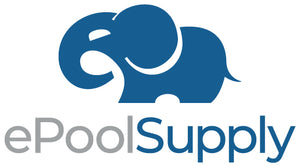Whether you're a new pool owner or a seasoned expert, keeping your swimming pool water clean and clear depends on regular maintenance. One of the most important steps is using pool shock treatment, but should you use chlorine shock or non-chlorine shock?
Both types of pool shock have their place in a proper pool care routine, and knowing when to use each can save you time, money, and stress. In this post, we’ll explore the differences between these two types of pool shock chemicals, their benefits, and when each is most effective, plus why ePoolSupply is your go-to source for all your pool supplies online.
What is Pool Shock?
Shocking your pool means adding a concentrated oxidizer to eliminate contaminants like bacteria, algae, sweat, sunscreen, and debris. This process helps maintain proper water chemistry, reduces chloramine buildup, and keeps your pool water crystal clear.
There are two main types of pool shock:
- Chlorine Shock (usually calcium hypochlorite or dichlor)
- Non-Chlorine Shock (potassium monopersulfate)
When to Use CHLORINE Pool Shock
Chlorine shock is a powerful pool sanitizer, ideal for major cleaning tasks and water problems. Use chlorine-based pool shock when:
- You see green or cloudy pool water
- After a heavy rainstorm or a pool party
- At pool opening or closing
- Chlorine levels are dangerously low
- You’re dealing with visible algae or bacteria
Benefits of Chlorine Shock:
- Quickly raises free chlorine levels
- Eliminates algae, bacteria, and organic waste
- Helps restore water clarity
- Ideal for algae treatment in pools
Pro tip: After using chlorine shock, wait 8–12 hours before swimming. Always test your pool water chemistry to ensure it's safe.
When to Use NON-CHLORINE Pool Shock
Non-chlorine shock, also known as oxidizing shock, is a chlorine-free pool treatment. It’s perfect for regular maintenance and quick cleanups without affecting chlorine levels.
Use non-chlorine shock when:
- You want to oxidize contaminants without adding chlorine
- You want to shock and go swimming the same day
- You’re performing weekly pool maintenance
- Your chlorine levels are already balanced
Benefits of Non-Chlorine Shock:
- Doesn’t increase chlorine levels
- Allows swimming within 15–30 minutes
- Helps reduce chloramines (the cause of “chlorine smell”)
- Perfect for spa and hot tub shock treatment
Chlorine vs. Non-Chlorine Shock: Which One is Right?
- Routine weekly maintenance? Use non-chlorine pool shock
- Clearing cloudy or green water? Go with chlorine pool shock
- Post-party cleanup? Chlorine shock is best
- Need quick swim access? Choose a non-chlorine oxidizing shock
Many pool owners alternate between both for optimal results — chlorine shock for heavy cleaning and non-chlorine shock for regular upkeep.
Why Buy Your Pool Shock from ePoolSupply?
At ePoolSupply, we’re more than just a pool supply store — we’re your pool care partner. Here's what sets us apart:
- 🛠️ Expert Support: Our experienced team can guide you on the best shock treatments for your pool.
- 🚚 Fast Shipping: Get your order delivered quickly so you can treat your pool without delays.
- 🏆 Top Brands: We stock only trusted, high-quality pool chemicals and supplies.
- 💲 Great Prices: Competitive pricing on all products — from pool shock to chlorine tablets and more.
When you buy from ePoolSupply.com, you're getting the best in pool care, customer service, and product quality.
Final Thoughts: Keep Your Pool Water Safe and Clear
Knowing the right time to use chlorine vs. non-chlorine shock is essential for every pool owner. Chlorine shock is best for fighting algae and bacteria, while non-chlorine shock is great for regular maintenance and fast reentry.
Need to stock up on pool shock?
Visit ePoolSupply.com today for the best selection of pool maintenance products, fast shipping, and expert advice you can trust.

